|
Gibson
Refrigerator Company in World War Two
Greenville, MI
1877-1900 as Belding-Hall Company
1900-1956 as Gibson Refrigerator Company
1956-1967 as part of Hupp
1967-1986 as part of White Consolidated Industries
1986-2006 as Electrolux
This page added 4-16-2021.
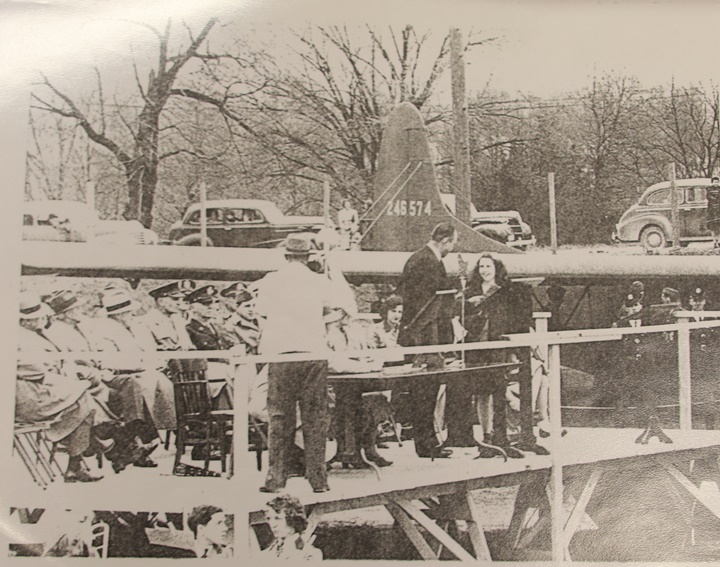
This photo shows a Greenville High School, MI
senior on the same podium with a group of adult civilians and military
personnel in Greenville, MI during World War Two. Gibson-built
CG-4A glider, serial number 42-46574, is behind the podium. This
is part of one of the most interesting stories of World War Two,
beginning in Greenville, MI and ending in Normandy, France on June 6, 1944.
Yet it is largely unknown to the general public and even to the majority
of World War Two historians, which included the author.
Photo courtesy of the Fighting Falcon
Military Museum.
I will come back to this photo later and give
a full explanation of what is happening.
For me, this webpage on the Gibson Refrigerator Company began with one of my many visits to the National
Museum of the United States Air Force in Dayton, OH. I was on a
photo shoot of different parts of aircraft for my research of several
different World War Two companies. Gibson was
not yet included on the list.
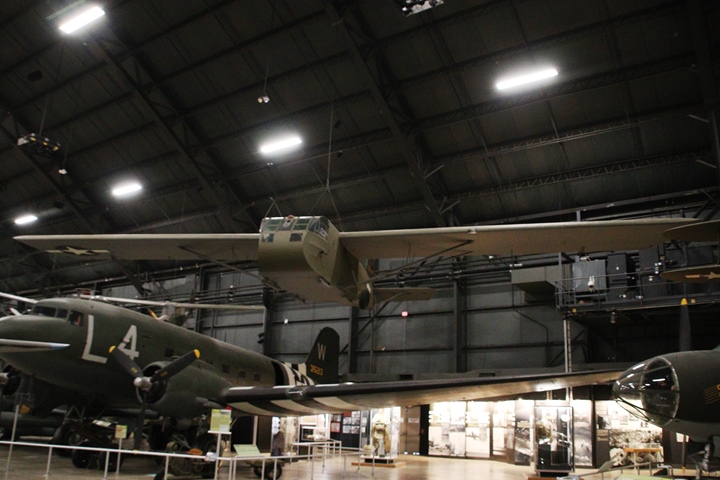
For some reason, I looked upward and took note of
this Waco CG-4A Hadrian glider that is hanging from the ceiling in the
museum's World War Two
hangar. I have walked underneath it many times over
the years and have looked up at it before. I walked over to the
information plaque and noted it was built by the Gibson Refrigerator
Company of Greenville, MI and was accepted by the Army Air Force in
July 1945. Looking at the manufacturer's name, I realized I could do
a
page on Gibson Refrigerator Company. In the past I had no doubt
noted the same information and done nothing with it. My focus on this
website has been evolving. Originally, the scope of this website
was exclusively the American Automobile Industry. In the past couple of years,
I have expanded the scope to include non-automotive companies. The scope of my website has changed
since its original inception in 2012.
I also remember thinking this should be a
relatively simple page to do. There was probably not much more
information on Gibson Refrigerator Company except how many of the CG-4A
gliders it built during the war. How wrong I was!

This Gibson-built CG-4A is serial number 45-27948
and is one of the 1,078 that the company built during World War Two.
Of the sixteen CG-4A gliders on display in museums world-wide, this is
the only one whose manufacturer is known.

Two weeks later, some research led me to the
Fighting Falcon Military Museum in Greenville, MI where Gibson
Refrigerator Company built the 1,078 CG-4A gliders. Author's
photo.
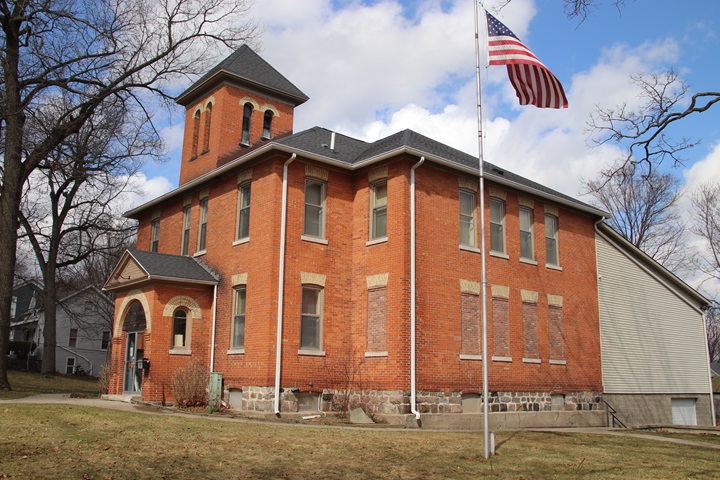
I have been to innumerable military museums
over the years. This is the first one I have visited that is in
a former schoolhouse. While this seems an unlikely location for a
military museum, appearances can be deceiving. Per
square foot of display area, this museum is the best I have ever visited
for telling the story of how the local companies helped win World War
Two. The museum not only has an excellent collection of items
relating to the Gibson Refrigerator Company, but also has information
related to other Greenville, MI companies. Author's photo.
This museum is well worth a visit for anyone
interested in World War Two history, although it is somewhat off the
beaten path and has limited visiting hours. However, by contacting
the museum, special appointments can be made to visit the museum.
This is what I did. It will be well worth the effort to visit the
museum.
An addition was added to the rear of the
original structure to house the CG-4A glider reconstruction which is the
centerpiece of the museum.

This leads one back to the original photo.
It was May 19, 1943. Sally Church, Greenville High
School senior, helped and maybe even led the effort for the Class of 1943
to raise $72,000 to purchase four Gibson CG-4A gliders. She is on
the podium with Frank Gibson, Jr., President of Gibson Refrigerator.
In March 1944, the school children of the town took it upon themselves to sell
enough war bonds to pay for one Gibson glider. In two months, they
raised $72,000, which actually paid for four gliders. One glider,
42-46574, was picked out and named by the students "The Fighting Falcon."
This was the naming ceremony. Photo courtesy of the Fighting Falcon
Military Museum.
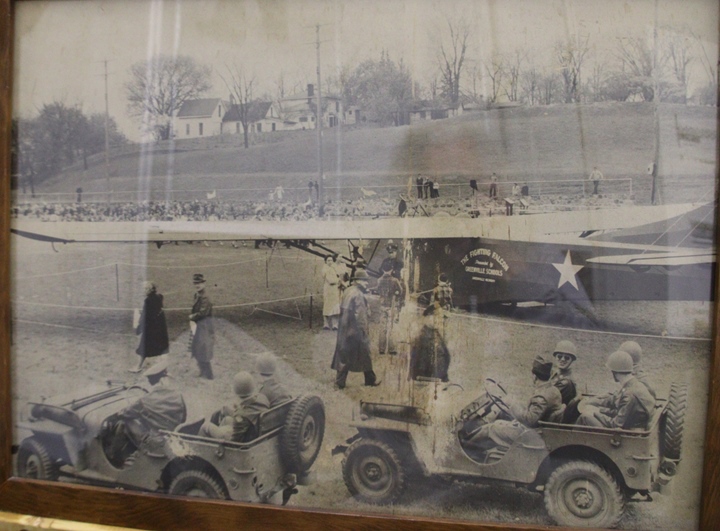
The Fighting Falcon was towed from the
factory to nearby Black Athletic Field for the ceremony.
Photo courtesy of the Fighting Falcon
Military Museum.
$72,000 in 1943 is $1,094,624 in 2021,
adjusted for inflation.
This was a herculean effort by the school children of Greenville.
One needs to remember there was no internet, no email, no Twitter, no GoFundMe,
nor any other modern method of communication. The only way
for them to get the word out to the public was through public service
messages on the local radio station and in the newspaper. Gas and
tires were being rationed, so any high school student with access to an
automobile would not be able to go very far, if anywhere at all.
During World War Two, if families had an automobile, they only had one.
It is not like today where families have several. So, to raise the
money the students had to go door-to-door to raise the funds. For
this, the 1943 Greenville High School class was awarded the U.S. Treasury
Distinguished Service Award. This was the first time this award
had been given to high school students.
The Fighting Falcon, serial number 42-46574,
like every other GC-4A glider, was disassembled and boxed up for
shipment. It was shipped to England where it was re-assembled.
This was fortuitous, as most of the 60 gliders built by Gibson ended up
staying in the United States as training aircraft. A few ended up
in North Africa and Sicily. After its re-assembly, the Fighting
Falcon was assigned to 434th Troop Carrier Group, which would be
transporting members of the 101st airborne into Normandy. In honor
of the Greenville Class of 1943, the Army Air Force designated the
Fighting Falcon, serial number 42-46574,to be the lead glider of the 52
in the first landing wave early in the morning of June 6,1944. As
the lead glider, the Fighting Falcon would carry Brigadier General Donald
Pratt and his aide, along with the general's jeep.
This is where the story gets complicated.
On June 4, 1944,the pilot of the Fighting Falcon, serial number 42-46574, LTC Michael
Murphy, decided to use another glider for the invasion.
This is because LTC Murphy was concerned about the safety of General
Pratt. Many of the other gliders for the invasion had extra
bracing installed on the fragile nose of the aircraft to protect the
occupants in case of a crash landing. This was known as a Griswold
Nose Protection Device. Therefore, LTC Murphy picked out the 45th glider
in the formation of 52. This turned out to be another Gibson-built
CB-4A, serial number 43-41430. It is unknown whether LTC Murphy
picked out another Gibson glider on purpose, or by chance. Serial
number 43-41430 became the lead glider in the group.
Again, the story becomes more complicated as
the new lead Gibson-built CG-4A glider was also named the Fighting
Falcon and had this quickly painted on the aircraft similar the
original glider. However, the lettering was considerably smaller.
Therefore, there were two Gibson-built CG-4A gliders named Fighting
Falcon that landed in
Normandy with the 101st Airborne on the morning of June 6, 1944. Landing in
the dark, the lead Fighting Falcon, serial number 43-41430, landed in a
small field and crashed into a group of trees at the edge of the field.
The sudden deceleration from an estimated 50-70 mph resulted in the
whiplash death of Brigadier General Donald Pratt, who was
sitting strapped in his command jeep in the glider. The
co-pilot, 2nd Lt. John Butler, was killed by an impact with a tree. LTC Murphy had two broken legs, and the general's aide, 1st Lt John May,
only suffered a concussion. At this point, the outcome of the
original Fighting Falcon's,serial number 42-46574, landing and status
afterwards is unknown.
Assault gliders like the "Fighting Falcon"
were only used during World War Two. They supplemented the
paratroopers by being able to bring in equipment and weapons that could
not be air-dropped. But it was dangerous to land a glider in the dark without the ability
to do a go-around like an aircraft. The "Fighting
Falcon," along with many other gliders, were destroyed upon landing, not
only at Normandy, but other landing zones during the war. After World War Two,
helicopter technology progressed to the point that they took over the
function not only of the glider but also, for the most part, the paratrooper.
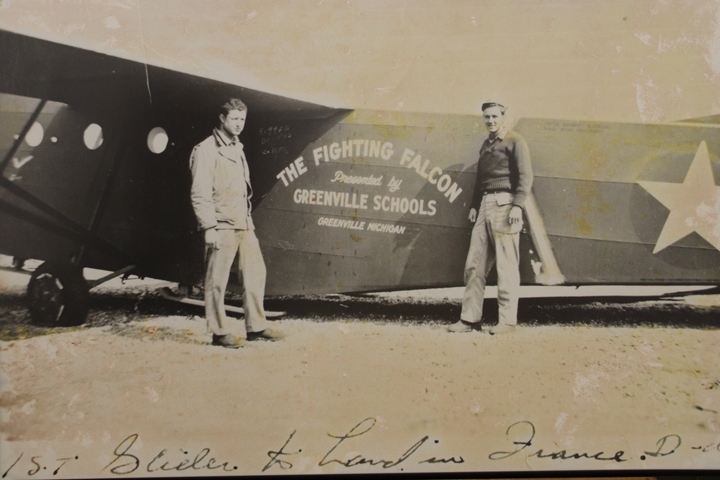
This photo shows the size of the
writing on the side of the original Fighting Falcon, serial number
42-46574. Photo courtesy of the Fighting Falcon
Military Museum.

A week after I visited the Fighting Falcon
Military Museum in Greenville, MI, I was at the Kentucky Military
History Museum in Frankfort, KY. There, mounted on the wall, is the fabric that
was removed from the second and lead "Fighting Falcon," serial number
43-41430. This was removed from the wreckage by an unidentified
airborne trooper and eventually became part of the Don F. Pratt Museum
at Fort Campbell, KY. The fabric is on loan to Kentucky Military
History Museum. Author's photo.
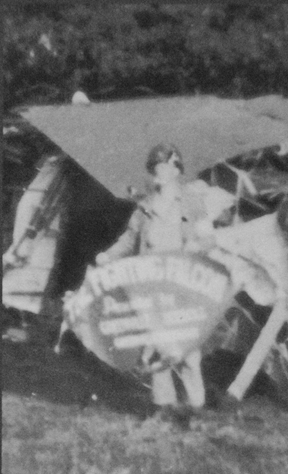
This airborne trooper has just removed the section of fabric from the
wreckage of the lead Fighting Falcon, serial number 43-41430. The size of the writing on the fabric is considerably
smaller than what was written on the original Fighting Falcon, serial
number 42-46574, at Greenville MI in May 1943.
Gibson Refrigerator Company World War Two
Products:
I had originally expected to only find
information on the number of gliders Gibson Refrigerator built during
World War Two. However, on my visit to the Fighting Falcon Museum
in Greenville, MI, I was able to learn more about its World War
Two products than I expected. My experience is that most companies'
war production is identifiable
with one main product. For Gibson, this was the CG-4A glider.
The Fighting Falcon Museum has a complete listing and many examples of
what the company built. The different products are listed in Table
1 below. Gibson actually started producing a variety of military products
before the United States entered the war. It was already in
production with many of these products when it took on the building of
gliders.
There were several other companies in
Greenville that manufactured products that helped win World War Two.
The museum also has information on these companies,
providing an excellent overall view of the manufacturing in the town
during the war. This information is in Table 3.
I grew up in Lansing, MI, which is 65 miles
away from Greenville, MI. I don't think I ever heard of
Greenville, MI while living in Lansing. I know I was unaware that
refrigerators were being built there.
Michigan built automobiles, not refrigerators. Therefore, I have
learned information about my home state because of a chance look at a
World War Two glider at the National Museum of the U.S. Air Force.
|
Table 1 - Gibson
Refrigerator Company World War Two Products
The information below was obtained from the Fighting Falcon
Museum in Greenville, MI. It in turn was provided to the
museum by Mr. William Delp, former Gibson Refrigerator Company
employee. Mr. Delp was a tooling engineer with Gibson, and
one of the engineers responsible for putting the CG-4A into
production. Without his historical knowledge of Gibson
during World War Two, the information below and at the museum
would have been lost forever. |
|
Quantity |
Product |
Comments |
| 1,078 |
CG-4A
Combat Gliders |
Gibson was fifth in the number of CG-4A gliders built by the
company.
It produced 7.7% of them. |
|
17,130 |
B-24
Wing Flaps |
These
were built
for the Ford Motor Company B-24 production at Willow Run, MI.
This quantity of flaps was enough for all of the B-24s built by
Ford. |
|
17,158 |
500
Pound Navy Practice Bombs |
|
|
750,000 |
Four
Pound Thermite Incendiary Bombs |
These
were built on contract W799-CWS-152. The original
contracted amount in mid 1941 was 700,182 for a cost of
$513,000. The contract was for only the bomb casings. The bomb casings were then
sent to an ordnance plant to be filled with explosive and
incendiary material. These were used in the low-level
firebombing raids by the B-29s over Japan. |
|
100,000 |
100
Pound Chemical Bombs |
|
|
53,052 |
AN-M26 Parachute Flares |
These
were built on contract W-374-ORD-1344 and W-374-ORD-1899.
The total cost of both contracts was $2,508,000 or $47.27 a
piece. The metal cases were made in the Greenville plant
and then shipped to Gibson's Blending Plant C. There, the
parachutes and flares were installed. |
|
41,860 |
165
Gallon Drop Tanks |
|
| 16 |
Multi-Spindle Lens Polishing Machines |
These
were for Argus Camera in Ann Arbor, MI, which was
making lenses for the Norden Bombsight. |
|
224,214 |
Parts
for 20mm Cannon |
The
information at the Museum indicates these parts were for 20mm Oerlikon
anti-aircraft guns and were supplied to Reo in Lansing, MI. Reo did
not make the 20mm Oerlikon nor did it do any sub-assembly work on them.
This leads to two different possibilities as to what 20mm parts
Gibson actually made. The first possibility is that the parts actually
went to Oldsmobile in Lansing, which did make 77,010 20mm M2
aircraft cannons. It sub-contracted out all of the parts for the
weapon and only did the final assembly. The location of
the Olds and Reo plants were within a mile of each other in
Lansing. Also, the names are similar because they were
both started by Mr. R.E. Olds.
The second possibility is if
they were actually 20mm Oerlikon parts, then they would have
gone either to the Pontiac Motor Division of GM in Pontiac, MI,
or to U.S. Navy's ordnance plant in Centerline, MI, which was
originally managed by the Hudson Motor Car Company, and then
later during the war by Westinghouse. Both locations
built the 20mm Oerlikon. |
|
299,929 |
AN-B-7 and AN-B10 Bomb Shackles |
These
were used by both the U.S. Navy and U.S. Army during World War
Two. The B-7 bomb shackle could hold 100 to 1,100 pound
bombs. The B-10 was for 100 to 1,600 pound bombs. |
| 1,500 |
Refrigerators |
These
were used for military housing. |
|
72,931 |
Sperry T-1 Aluminum Computer Cabinets |
These
went to the AC Spark Plug Division of General Motors which was
building the Sperry Computers under license. The original
design was British, with Sperry building them under license.
The T-1 bombsight was used in several RAF bombers and was well
suited for the night bombing that the RAF engaged in during the
war. |
|
144,914 |
Sets
of Aircraft Parts |
These
were for the Packard-built Rolls-Royce V-1650 Merlin aircraft
engine. |
|
64,295 |
Gear
Blanks for Tank Engines |
These
were for use in tank engines built by Continental Motors Company
in Muskegon, MI. The parts would have been used in either
or both the W-670 and R-975 radial tank engines. |
|
15,754 |
Sets
of Bomb Hoisting Bands |
These
were produced for the Cook Electric Company of Chicago, IL. |
| 105
|
Sets
of Drop Tank Internal Parts |
These
were produced for the Tappan Stove Company of Cleveland, OH. |
| 1,646 |
Rotary Vibrators |
These
were made for the Bendix Aviation Company of South Bend, IL. |
|
Thousands |
40-Inch Electric Ranges |
These
were used for military housing and built in Gibson's Belding, MI
plant B. |
|
Table 2 - Gibson Refrigerator Company CG-4A Contracted Serial
Numbers |
|
U.S. Army Air Force Serial Numbers |
Number |
Comments |
|
42-46552 through 42-46611 |
60 |
42-46574, the original Fighting Falcon, was one of several from
this group to end up in Normandy. Other gliders in this
group were used as trainers in the U.S. Others were sent
to Tunisia and Sicily. |
|
42-46619 through 42-46631 |
13 |
Several of the CG-4As in this group went to the RAF.
|
|
42-52853 through 42-52881 |
29 |
Several of the CG-4As in this group went to the RAF.
|
|
42-55785 through 42-55844 |
60 |
42-55833 was part of Operation Varsity landing 17 Airborne
Division to Wesel, Germany on March 24, 1945. Many others
were transferred to the RAF from USAAF inventory in India. |
|
42-68306 through 42-68335 |
30 |
42-68334 landed with the 82nd Airborne Division at St. Mere-Eglise
in Normandy on June 6,1944. |
|
42-73750 through 42-74112 |
363 |
Gibson gliders from this group served in Tunisia, Sicily, and
Normandy. |
|
43-41279 through 43-41778 |
500 |
Many
of the CG-4As in this group served at Normandy and Operation
Market Garden. |
|
45-27936 through 45-27948 |
13 |
45-27548 is on display at the National Museum of the United
States Air Force. It is the CG-4A Hadrian glider that
initiated this page for the
website. |
|
45-27949 through 45-27961 |
13 |
Three
units cancelled. |
|
45-27962 through 45-27971 |
10 |
Order
cancelled. |
|
Total |
1,091 |
|
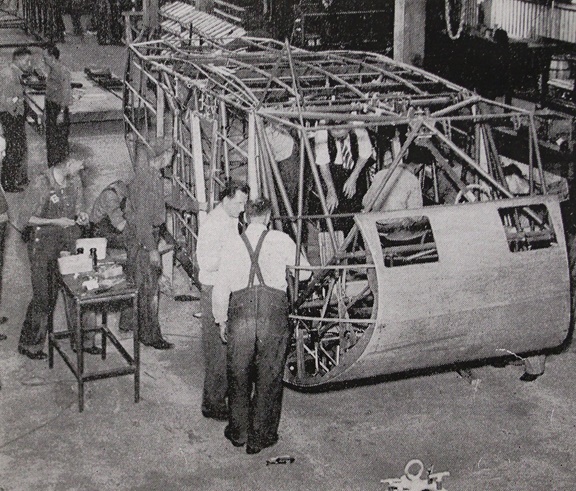
Glider production at Gibson Refrigerator
Company during World War Two. Photo courtesy of the Fighting Falcon
Military Museum.

Photo courtesy of the Fighting Falcon Military
Museum.
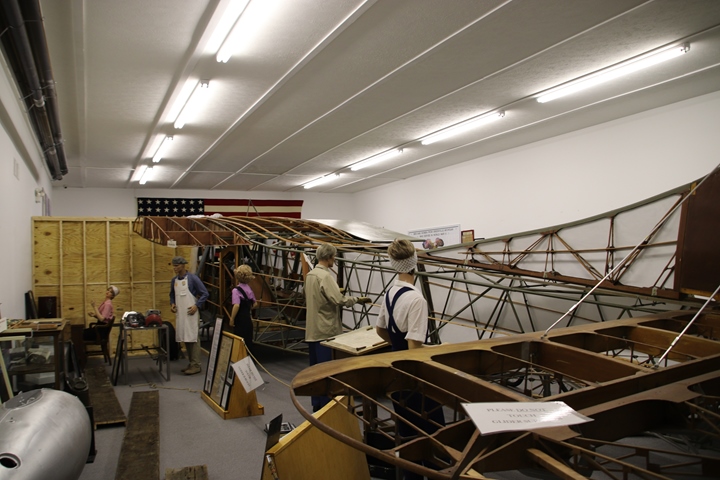
This is what one first sees when entering
the addition to the Fighting Falcon Military Museum, which was added to
display this reconstruction of a Gibson-built CG-4A glider. This
side of the glider does not have the fabric attached to it, and
represents a full-size diorama of a glider under construction.
Author's photo.
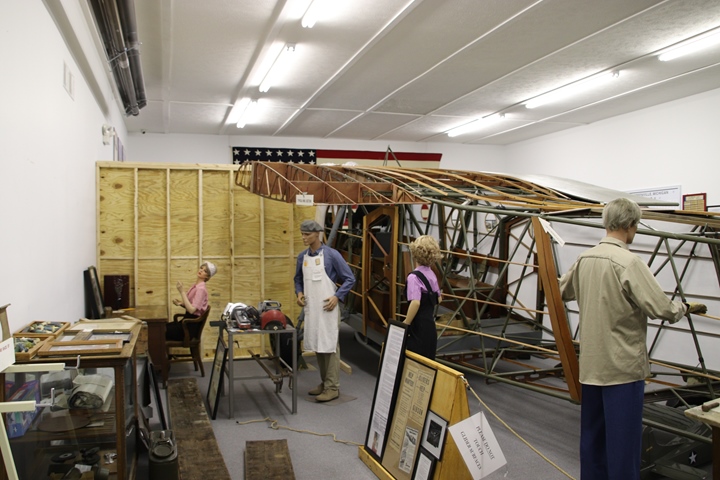
Many of the parts for this reconstruction came from the local area.
Many others came from across the United States as word spread of the
project. At the end of World War Two, Gibson had 60 gliders packed
in 300 crates ready for shipment. However, they were no longer
needed, and the company sold each crate for $50 each. Many were
purchased for the wood in the crates, which was used by local farmers to
build small buildings. For the most part, the glider parts were
thrown away or left in a field. The center section of
this glider is the assembly of three center sections found on farms in
the Greenville and Belding areas. The three provided enough good
parts to make one glider for this reconstruction. Author's photo.

Each of the following photos shows a
different section of the glider and all of the different parts that went
into its construction. The tail section of the fuselage came
from a barn ten miles east of Greenville. Author's photo.

The vertical and horizontal
stabilizers, along with the rudder, came from a farm in New Hampshire.
Author's photo.
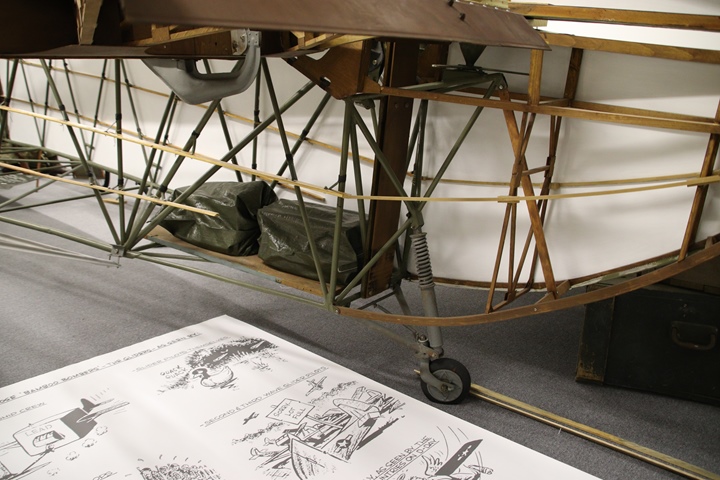
Author's photo.
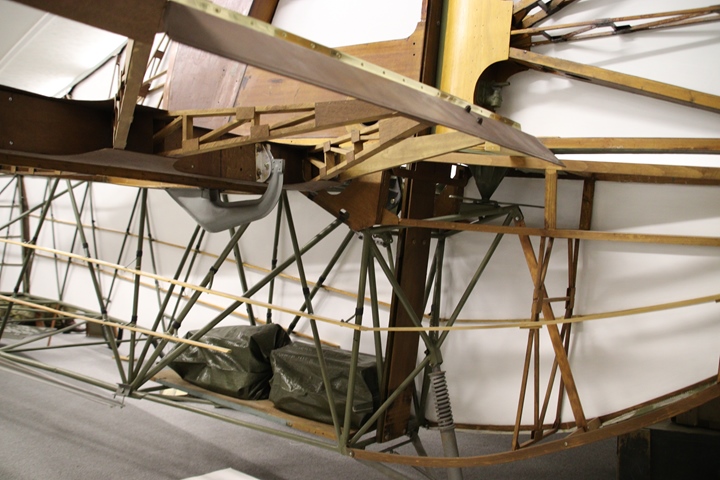
The tail section had two weighted bags
installed to provide the proper weight and balance for the glider.
Author's photo.

Author's photo.
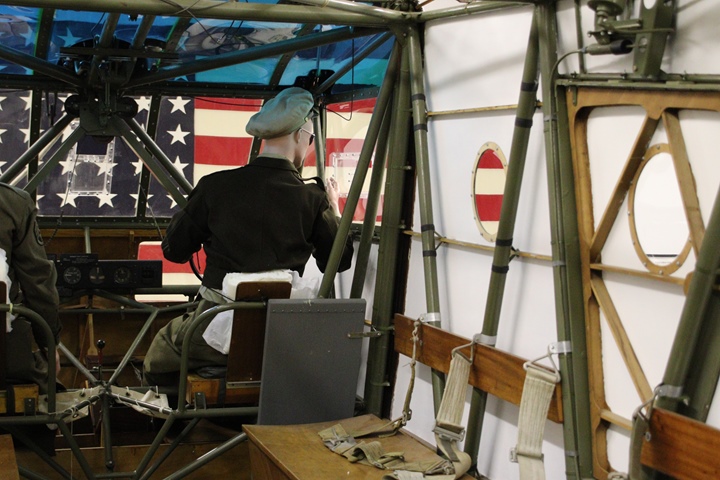
Author's photo.

Author's photo.

The landing gear was found at an aircraft parts collector in Chicago,
IL, while the wheels and tires were donated by the Kalamazoo Air Museum.
Author's photo.

The other side of the glider has been
covered with fabric and painted. Author's photo.
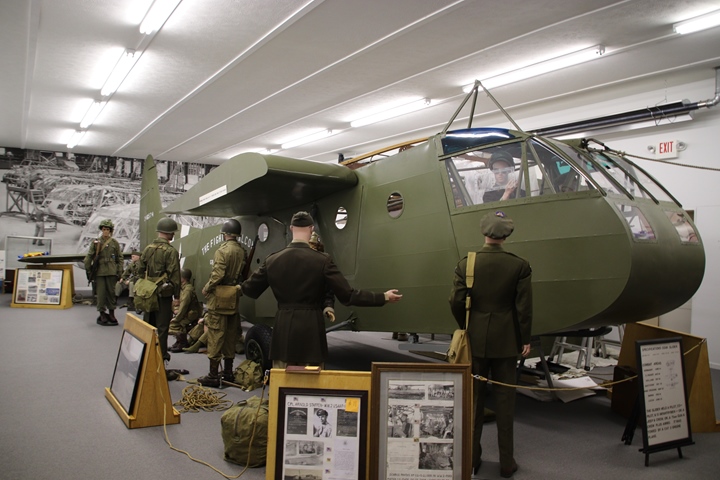
The wings were too large for the addition
made to the former school, so only the center section of the wings were
added. Author's photo.

The tow rope is attached to the top of the
fuselage. A communication cable ran down the center of the tow
rope so the pilots in the glider and tow aircraft could
communicate with each other. The tow plane pilot needed to notify the glider when
it needed to release the cable to land in the combat zone. Author's photo.
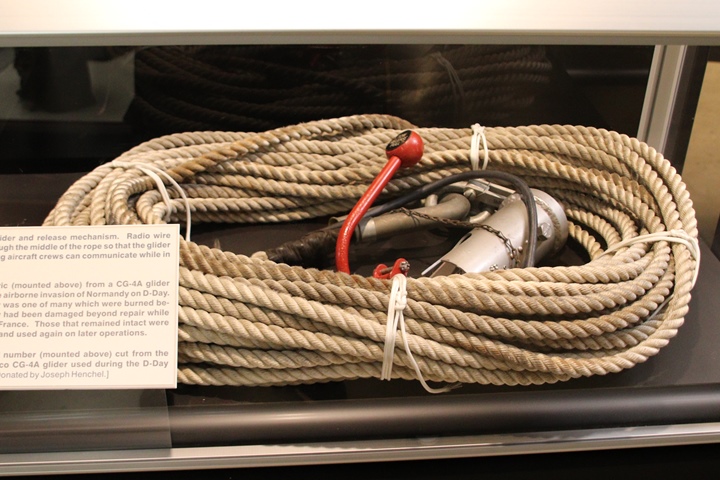
This original World War Two glider tow rope
is on display at the National Museum of the United States Air Force.
The tow rope was a complete assembly that included the shackle that
attached to the tow aircraft, the rope and then the attachment and
release lever that attached to the glider. The electrical cable
that allowed communication between the tow aircraft and the glider ran
down the middle of the two rope. It is the black rubber cable. The
release handle is the red device. Author's photo.
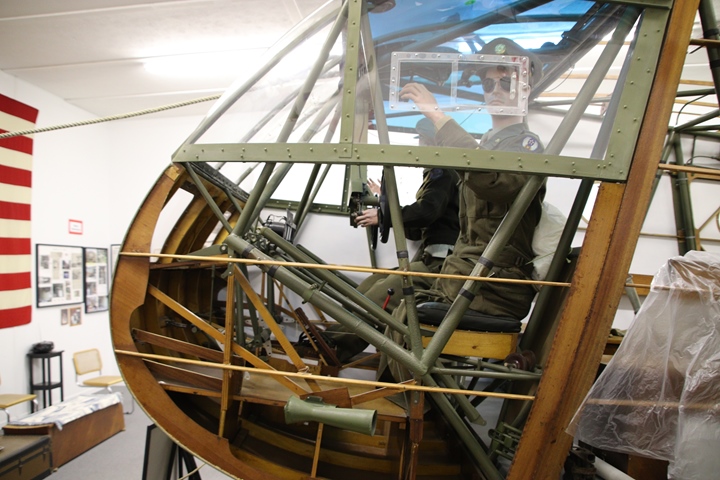
The metal frame for the nose section came from Ohio
and has some of the original larger steel tubing in it.
However, if it the glider crashes into a grove of trees, as the Fighting
Falcon did at Normandy, the front end is going to collapse. Author's photo.
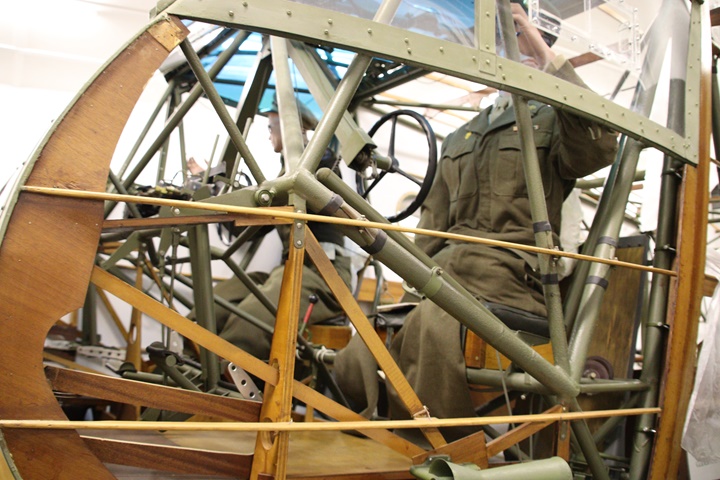
Author's photo.

The co-pilot's control wheel came from a garage sale in Greenville.
The instrument panel was found on a farm in Pennsylvania. Author's photo.
Other CG-4A Gliders and Pieces:
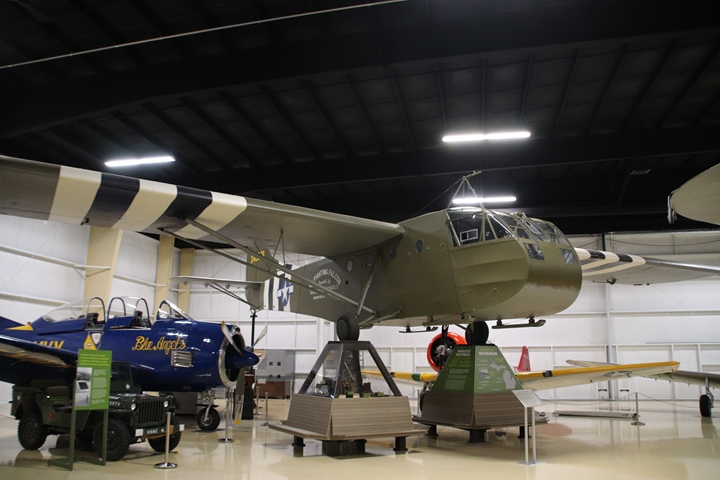
This CG-4A glider on display at the
Kalamazoo Air and Space Museum has been named the Fighting Falcon.
Author's photo.
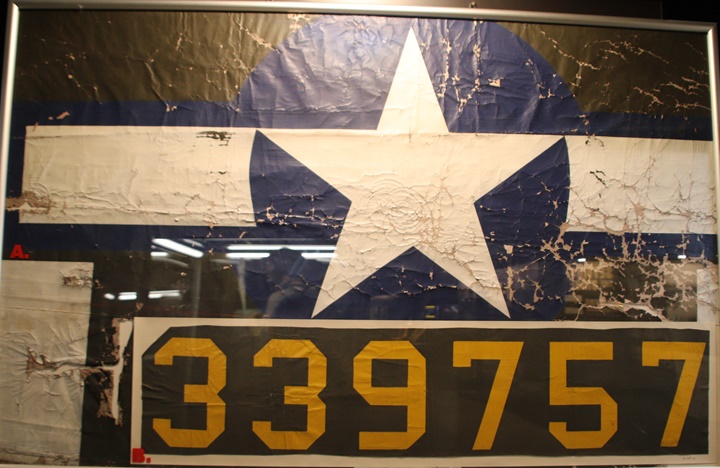
This is the fabric that was cut from the
Ford-built CG-4A glider that also crashed at Normandy. It is on
display at the National Museum of the United
States Air Force. Thirty-eight percent of all of the CG-4A gliders
were built in Michigan by the Ford Motor Company and the Gibson
Refrigerator Company. Author's photo.
Other Gibson Refrigerator Company World War
Two Products:
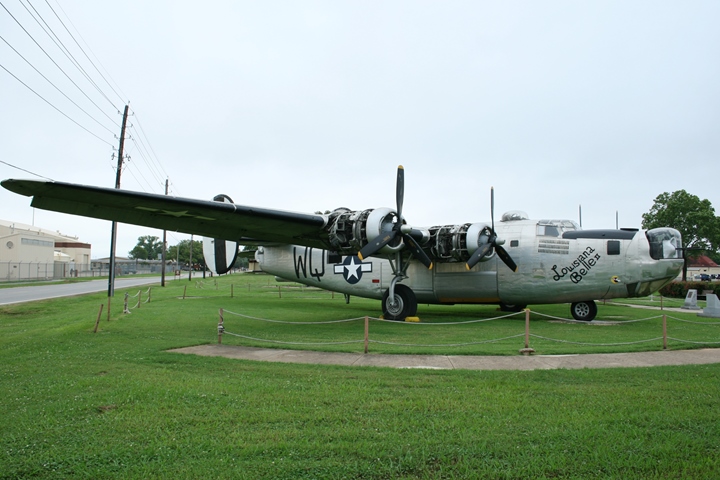
This Ford-built B-24J is on display at the
Barksdale Global Power Museum at Barksdale AFB in Bossier City, LA.
The aircraft has Gibson Refrigerator Company-built flaps on it.
Author's photo.
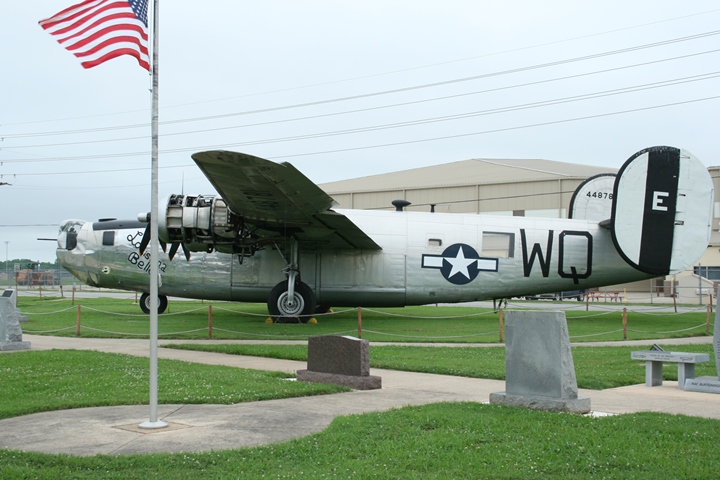
Gibson was Ford's largest sub-contractor. Author's photo.

Here is the port side Gibson flap.
Author's photo.
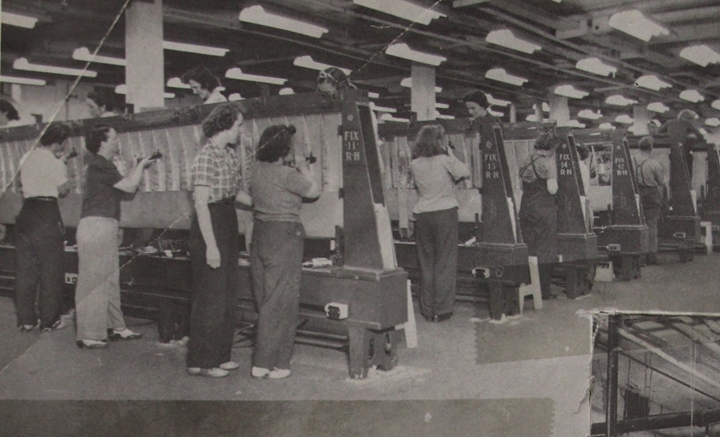
This factory photo shows the wooden fixtures
that were used to build the flaps. The operators in view of the
camera are holding rivet bucking bars. On the other side of the
flap are other operators that have rivet guns. The bucking bar is
pushed up against the rivet to flatten the rivet. The operator at
the right end of the "Fix-11-RH" appears to be new on the job, as a
supervisor is showing her how to buck rivets. The numbers on the
fixtures show that there were at least thirteen of them for the right
hand flaps. Each fixture has at least eight operators installing
the rivets, and there were thousands that were used in the construction
of each one. This was a very labor intensive and tedious
operation. Photo courtesy of the Fighting Falcon Military Museum.
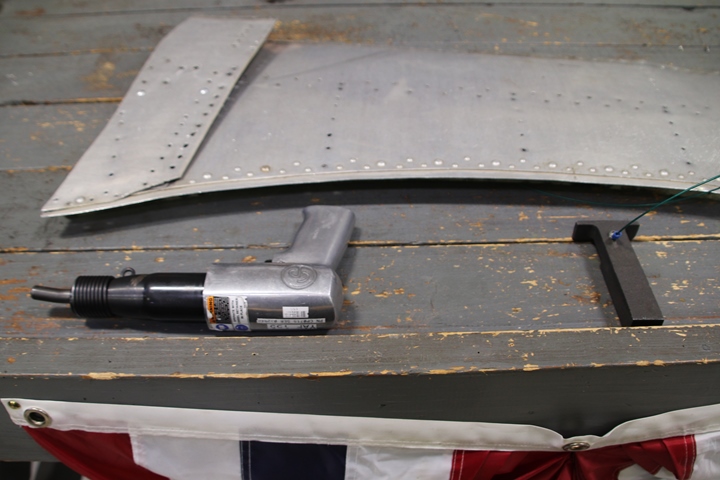
On the left is an air-powered rivet gun and
on the right is a bucking bar. The operator with the rivet gun
would push a rivet through the pre-drilled holes in the sheet metal
pieces being riveted together. The other operator would then push
up against the un-flattened end of the rivet with the bucking bar while
the rivet gun hammered against the head from the opposite side.
The vibration caused the rivet to flatten under the bucking bar.
Above the tools is an example of sheet metal with some rivets in it.
Rivets held World War Two sheet metal parts and aircraft together.
There were probably tens of thousands used in each flap Gibson made for
the Ford B-24s. This was tedious yet very important work for the
operators. Author's photo.
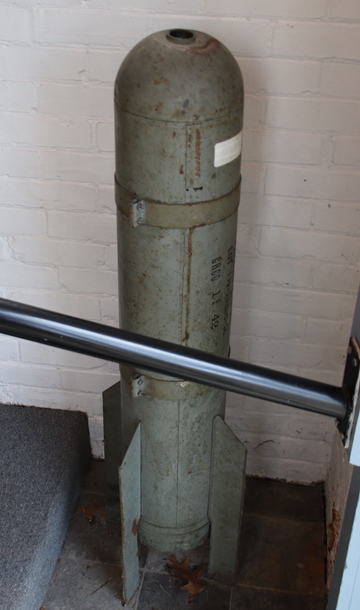
This AN-M26 aircraft flare container was
built by the Gibson Refrigerator Company in November 1942. The
AN-M26 would be dropped by an aircraft over an area for night photo
reconnaissance missions. The parachute would allow the flare to
stay in the air long enough to burn a yellowish color of 800,000
candlepower for up to three minutes. Gibson built 53,052 of these.
Author's photo from the Fighting Falcon Museum.
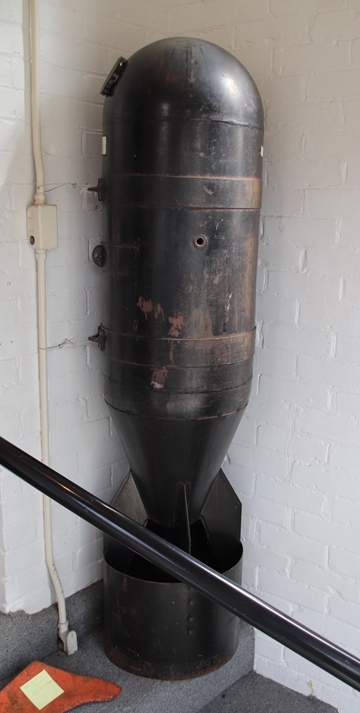
The practice bomb had all of the ballistic
characteristics of the normal 500 pound bomb. The U.S. Navy would
fill the practice bombs with sand and flour, so when the bombs struck the
practice target area it could be seen where they hit. Author's
photo from the Fighting Falcon Museum.
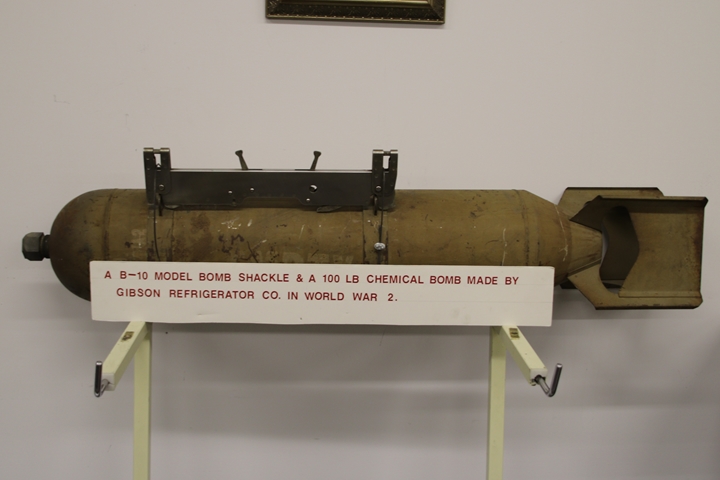
This stainless steel AN-B10 bomb shackle and 100 pound
chemical bomb are on display in the Fighting Falcon Museum.
Author's photo from the Fighting Falcon Museum.

One hundred pound chemical bombs are
traveling on a monorail at the Gibson plant. The bombs in the
foreground appear to be coming out of the paint shop. Photo
courtesy of the Fighting Falcon Military Museum.

Gibson produced 750,000 four pound thermite
incendiary bombs during the war. It only produced this outer
casing, as the internal incendiary and explosive material were installed
at an ordnance plant. This example at the Fighting Falcon Military
Museum is the only one the author has found in his research.
Author's photo from the Fighting Falcon Museum.
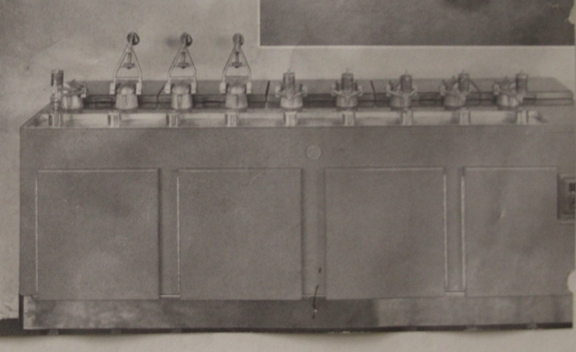
Gibson built sixteen multi-spindle lens
polishing machines for Argus Camera in Ann Arbor, MI. Argus used
them to polish lenses for the Norden bombsight. Photo courtesy of
the Fighting Falcon Military Museum.

This drop tank was produced at the end of
the war and immediately became surplus. This and a second drop
tank were found in the barn of two of the officers of the museum.
The second drop tank is at the Air Zoo Aerospace Museum in Kalamazoo,
MI. Author's photo from the Fighting Falcon Museum.

Gibson built 41,860 drop tanks to extend the
range of American fighter aircraft during World War Two. Author's
photo from the Fighting Falcon Museum.
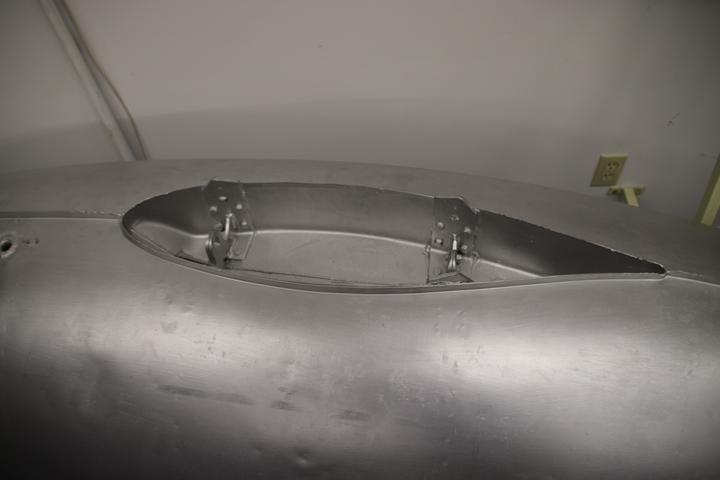
Author's photo from the Fighting Falcon
Museum.

This finished drop tank is on display at the
National Museum of WWII Aviation in Colorado Springs, CO. Author's
photo added 5-5-2021.
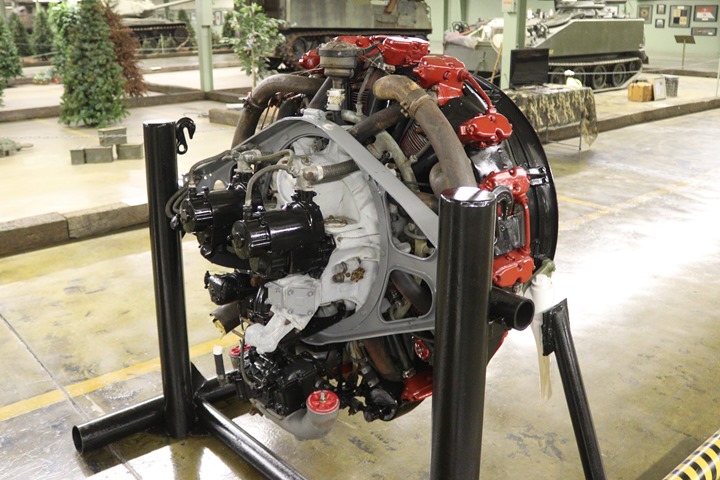
Gibson produced
64,295 gear blanks for radial tank engines built by Continental
Motors in nearby Muskegon, MI. This is an example of a Continental
R-975 that was used in various tanks during World War Two. The
most famous tank in which it was used was the M4/M4A1 Sherman tank. Author's photo.
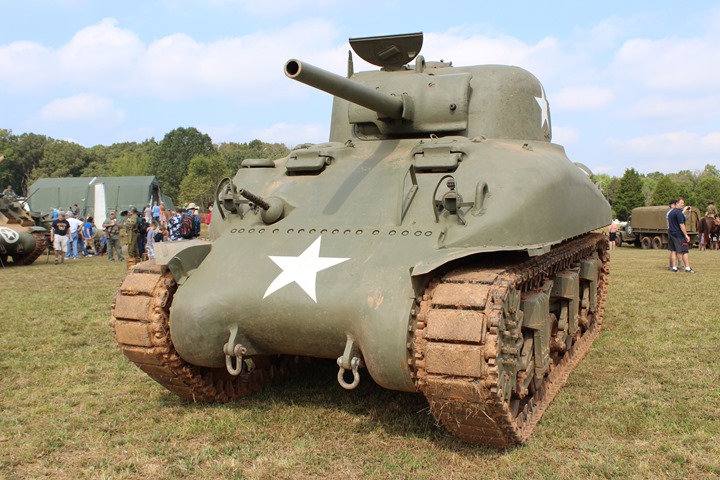
This is an early World War Two M4A1 Sherman
tank powered by the Continental R-975 engine. Author's photo.

Another armored vehicle that utilized the
R-975 engine was the M18 Hellcat tank destroyer produced by Buick in
Flint, MI. Author's photo.
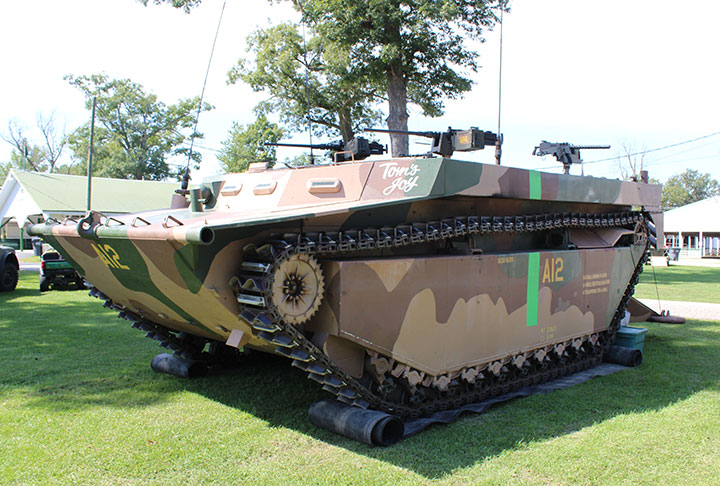
Continental also produced a smaller radial
engine, designated the W-670, which was used in armored vehicles.
One such application was the LVT-4. Many of these were built by
the Graham-Paige Motors Company in Detroit, MI. Author's photo.
Gibson-built gear blanks could have been used
in over a dozen different types of armored vehicles during World War
Two.
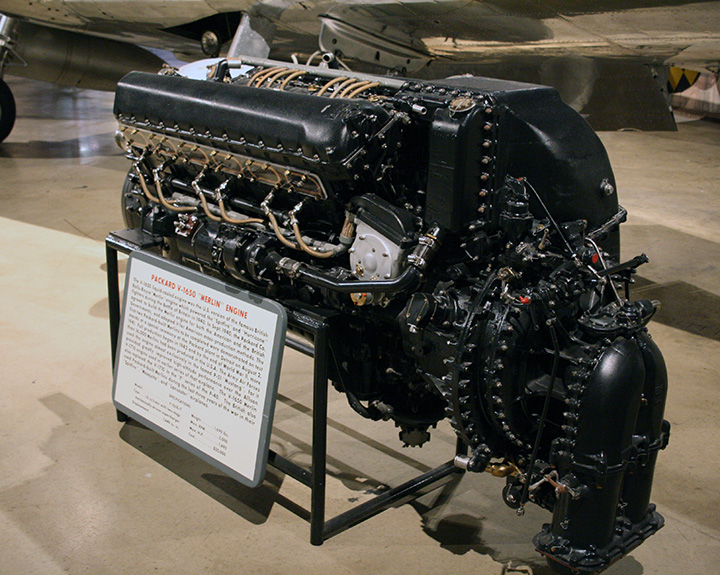
The Packard V-1650 Merlin engine is
legendary for its high altitude performance in the P-51 Mustang over
Europe in World War Two. Gibson Refrigerator helped this
performance by producing 144,914 parts for the 54,714 engines built. Author's photo.
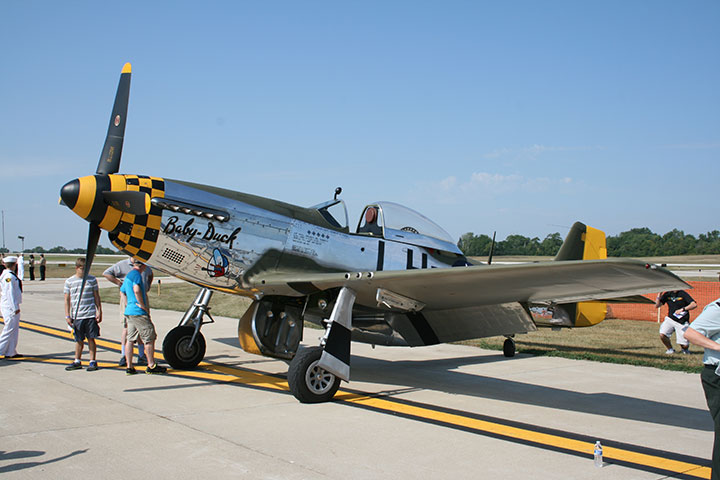
The North American P-51. Author's photo.
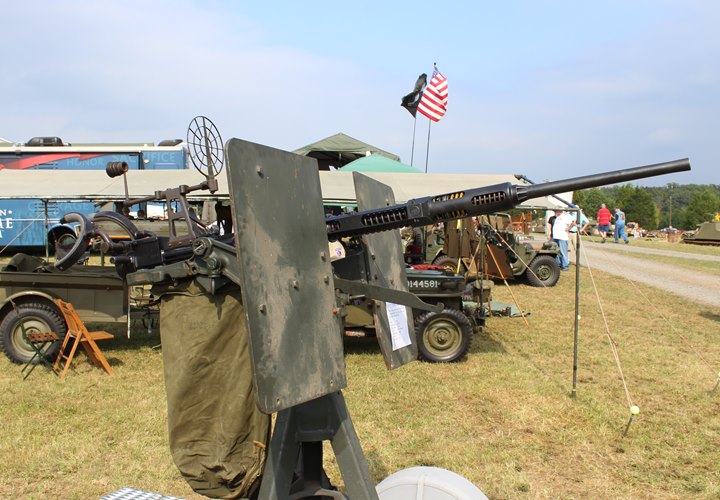
This is a Pontiac Motor Division-built 20mm
Oerlikon anti-aircraft gun. Gibson produced
224,214 components for this weapon. Author's photo.
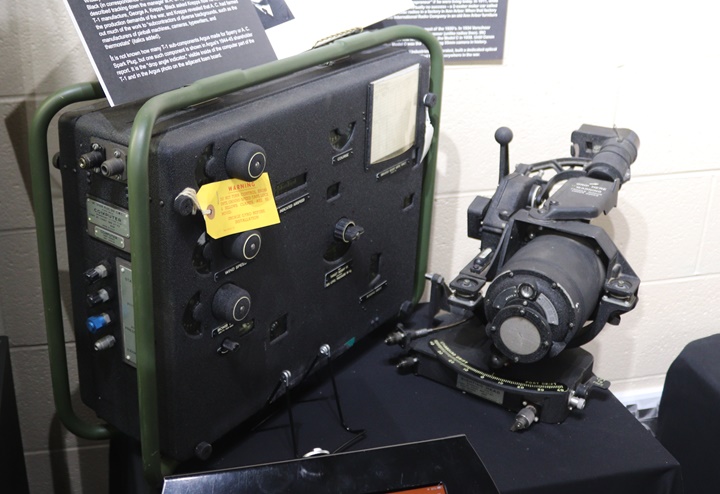
This Sperry T-1-A bombsight computer in the
left of the photo was built by A-C Sparkplug in Flint, MI. It was
used with the sighting head also shown and was used by the Royal Air
Force in many of its bombers. Gibson produced
72,931 T-1-A cabinets for AC Spark Plug during the war. Author's photo.
Gibson Refrigerator
Plants:
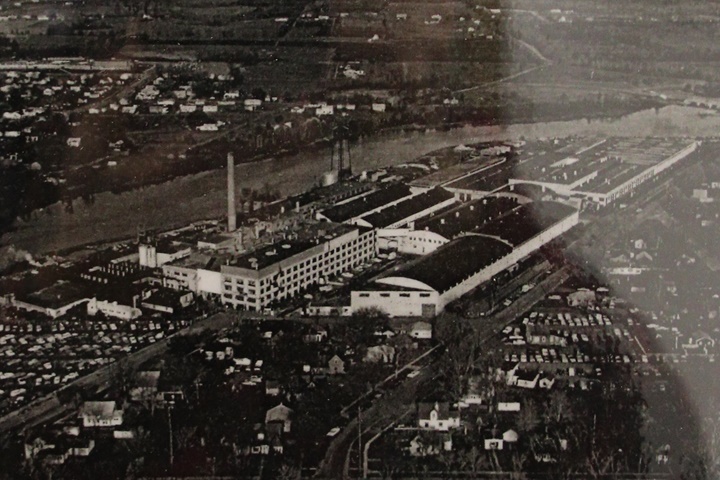
This is the Gibson Refrigerator complex in
Greenville, MI in the early
1950s. Photo courtesy of the Fighting Falcon Military Museum.
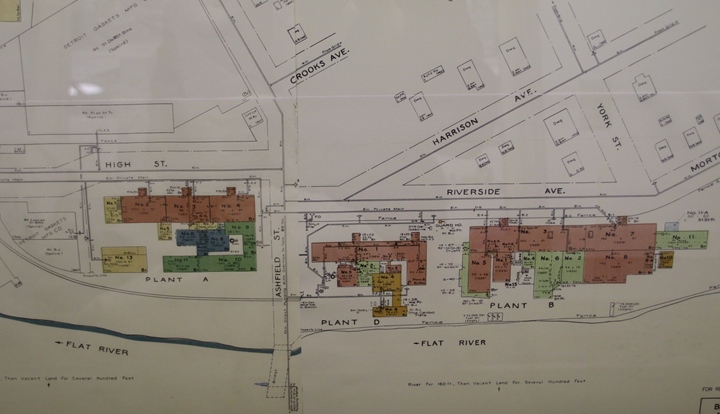
Gibson also had several factories in
Belding, MI, several miles to the south of Greenville. Photo
courtesy of the Fighting Falcon Military Museum.
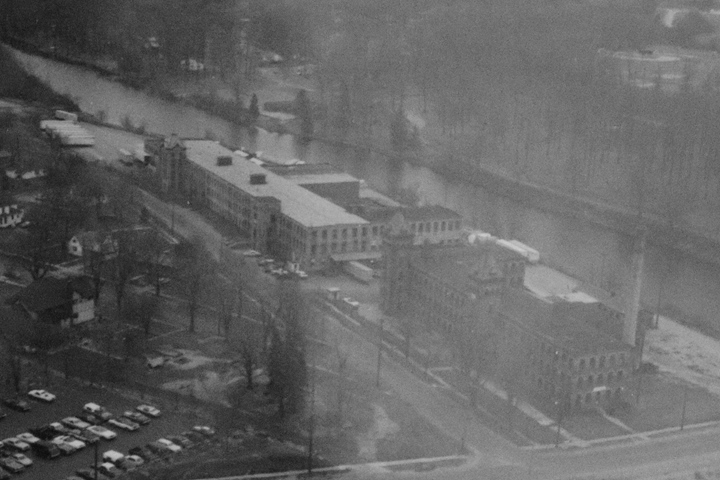
This is plant
B and D in Belding. Photo courtesy of the Fighting Falcon Military
Museum.
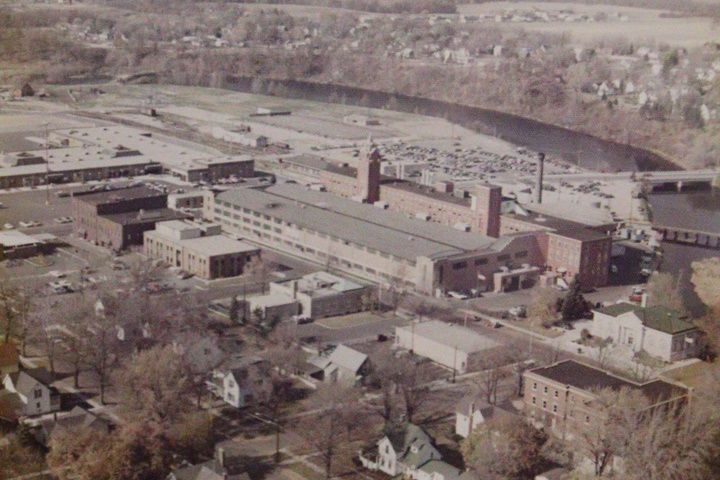
This is plant E in Belding. Photo
courtesy of the Fighting Falcon Military Museum.
Gibson Refrigerator Post-World War Two
Military Products:
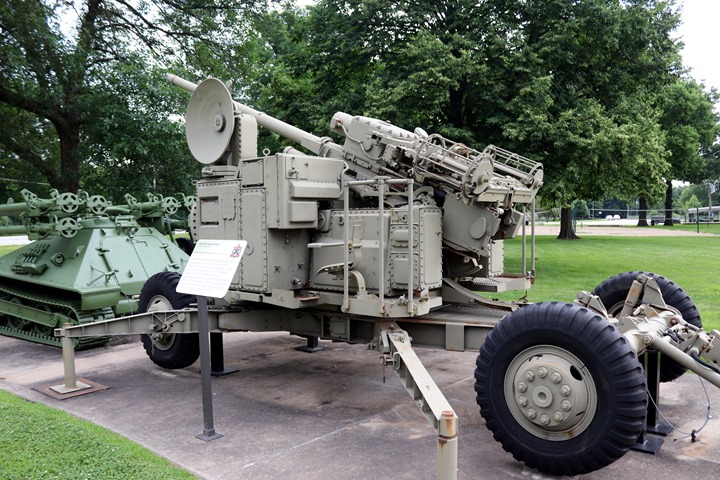
Gibson built the wheel bogies for the M51
Skysweeper 75mm anti-aircraft gun. This weapon was developed to
protect American cities from a Soviet air attack after World War Two. The small number of weapons that were built were quickly replaced by the Nike
anti-aircraft missile system. Gibson also made the shells for this
weapon. Author's photo.
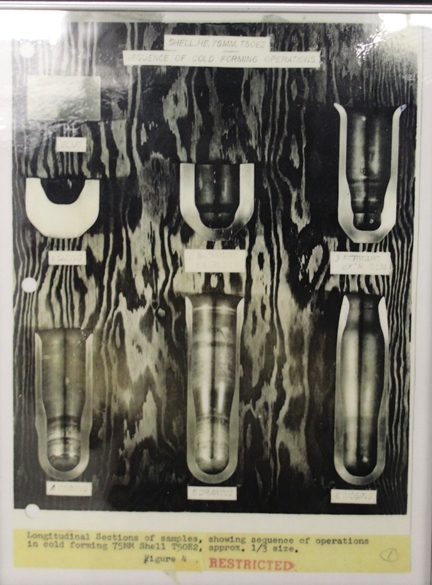
This photo shows the progression of the cold
forming process Gibson used to make over a million 75mm shells for the
Skysweeper anti-aircraft gun. Photo courtesy of the Fighting
Falcon Military Museum.
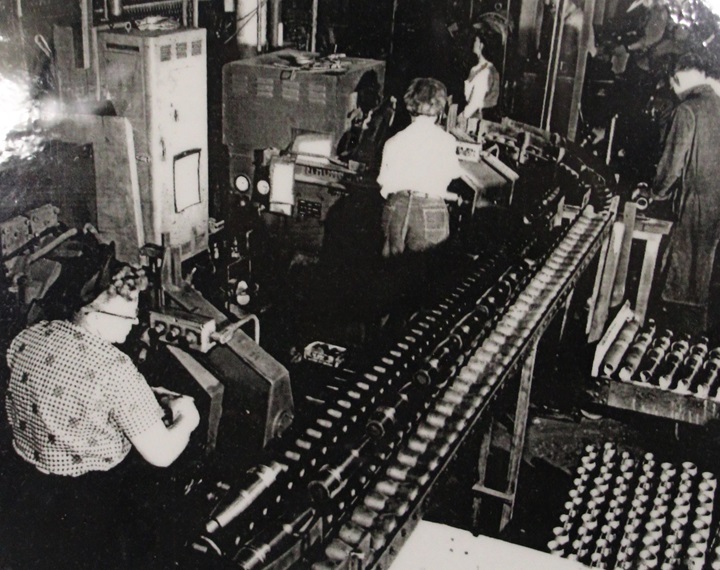
On October 20, 1954 Gibson produced its
millionth 75mm shell. Photo courtesy of the Fighting Falcon
Military Museum.
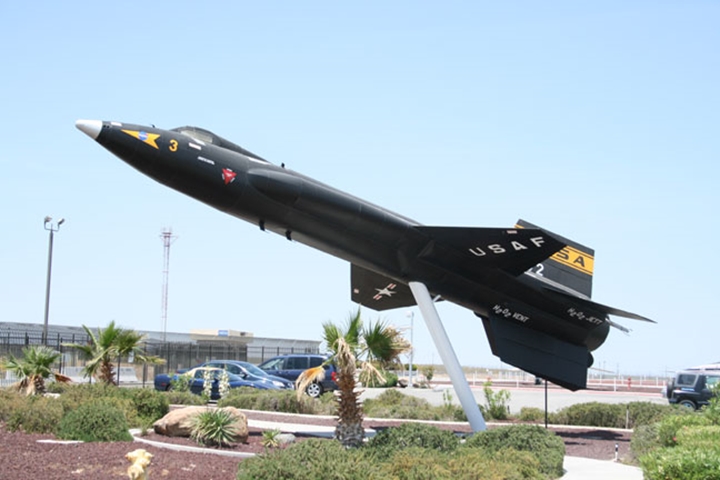
Gibson also built engine parts for the X-15. Author's photo.

The company also produced parts for the
C-119 that was built by Kaiser-Fraser in the former Ford Motor Company
B-24 plant at Willow Run, MI. Author's photo.
Other Greenville, MI World War Two
Manufacturers:
|
Table 3 -
Greenville, MI Company World War Two Products
The information below was obtained from the Fighting Falcon
Museum in Greenville, MI. It in turn was provided to the
museum by Mr. William Delp, former Gibson Refrigerator Company
employee. |
|
Company |
Quantity |
Product |
Comments |
| Metzgar Ltd. |
|
20,000 lbs./per
day of Dehydrated Potatoes |
These were
purchased by the Army, Navy, Lend-Lease Agency and the British
Maritime Commission |
| Belshaw
Manufacturing Company |
|
CG-4A Pilot and
Co-Pilot Seats, Three Man Seats and Vertical Stabilizers |
These were built
under sub-contract to Gibson |
| Greenville
Machine Company |
|
Various Stampings
and Machined Parts |
These were for
products built by Gibson, Ranney, and Towers |
| Wolverine Shoe
and Tanning Corporation, Glove Division |
|
Various Military
Gloves |
The primary
product was all leather, heavily insulated gloves for the Army
Air Force. These were used by American bomber flight
crews. |
| Ranney
Refrigerator Company |
|
Front Panel for
Sperry T-1 Computer |
This was a
sub-contract to Gibson. |
| Ranney
Refrigerator Company |
|
20mm Oerlikon
Anti-Aircraft Gun Parts |
These were built
under sub-contract to Gibson. |
| Ranney
Refrigerator Company |
|
Various Wooden
Ammunition Boxes and Crates |
These were
produced for both the Army and Navy. |
| R.J. Tower Iron
Works |
|
Thousands of
Bench Mounted Grommeting Machines |
These were used
to fasten metal grommets to all types of cloth material. |
| R.J. Tower Iron
Works |
|
Various Stampings |
These were
sub-contracted from Gibson |
| Federal-Mogul |
|
Brass Castings
for Marine Propellers |
Federal-Mogul
Produced all of the propellers for American-built PT and rescue
boats. It also produced the propellers for the DUKW. |

Federal-Mogul produced three propellers for
each of the 531 PT boats built during World War Two. This is
Higgins-built PT-305 located in New Orleans, LA. Author's photo.
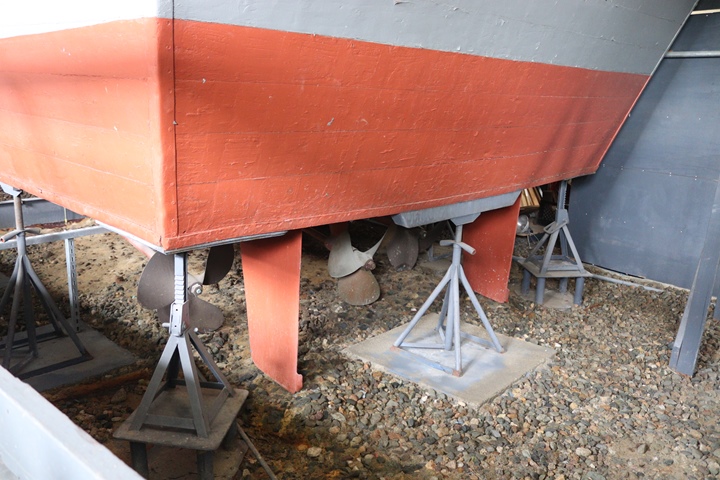
This is the aft end of Higgins-built PT-796
at Battleship Cove, MA, which shows the Federal-Mogul-built propellers.
Author's photo.
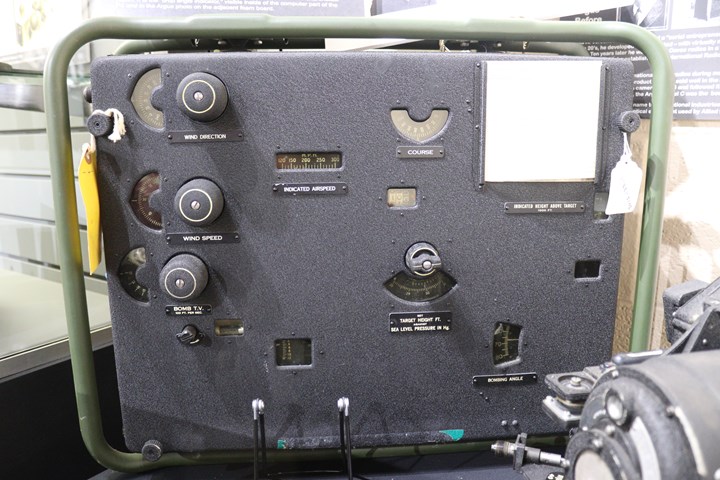
Ranney Refrigerator in Greenville, MI
stamped out the front T-1 bombsight computer panels under sub-contract
to Gibson during World War Two. Author's photo.
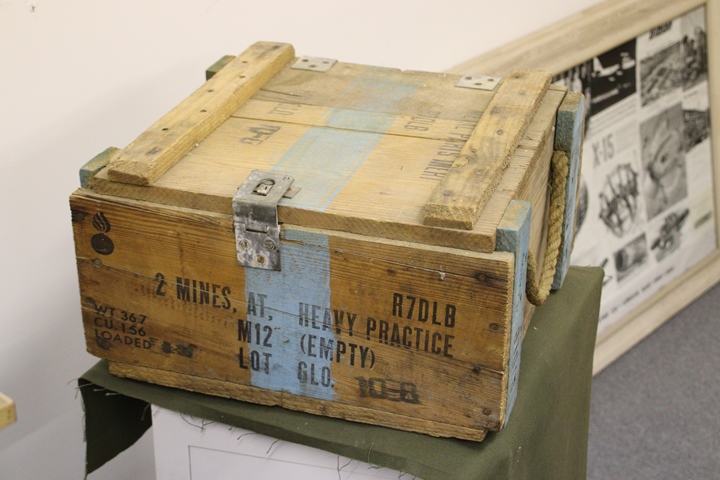
Ranney also built large quantities of wooden
boxes for both the Army and the Navy. Author's photo from the
Fighting Falcon Museum.
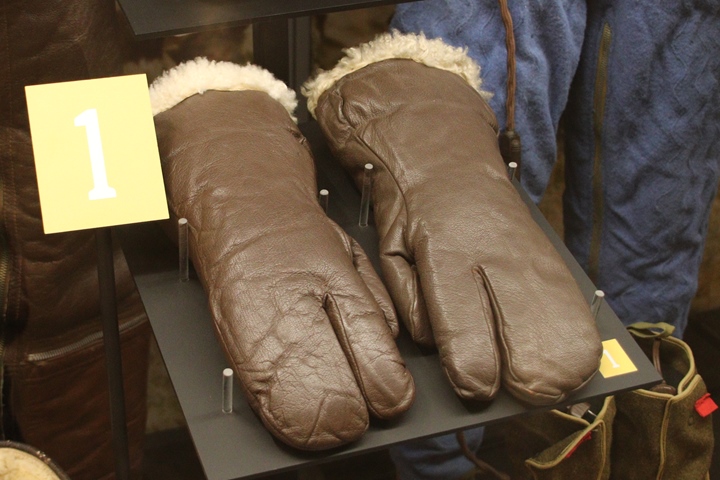
The Wolverine Shoe
and Tanning Corporation, Glove Division in Greenville, MI made
heavy, insulated gloves like this for bomber crews. Author's
photo. |


































































